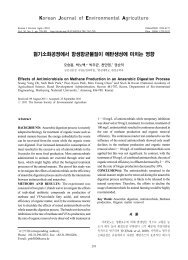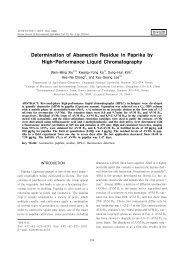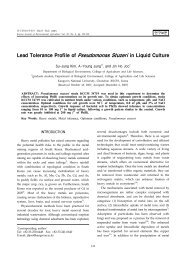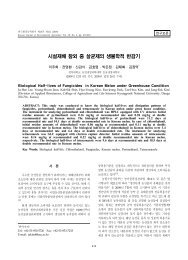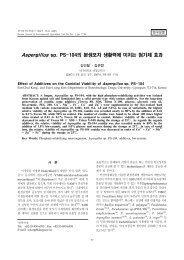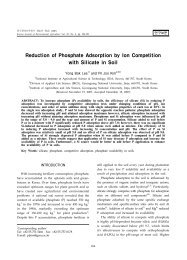06(ìë£)KJEAE-57-(ì¬ì¬í)Residual analysis of insecticides.hwp
06(ìë£)KJEAE-57-(ì¬ì¬í)Residual analysis of insecticides.hwp
06(ìë£)KJEAE-57-(ì¬ì¬í)Residual analysis of insecticides.hwp
You also want an ePaper? Increase the reach of your titles
YUMPU automatically turns print PDFs into web optimized ePapers that Google loves.
258<br />
Lina Hem, Jong-Hyouk Park and Jae-Han Shim<br />
cyhalothrin also functions effectively as a vector<br />
control agent.<br />
Lufenuron, (RS)-1-[2,5-dichloro-4-(1,1,2,3,3,3-hexafluoropropoxy)phenyl]-3-(2,6-difluorobenzoyl)<br />
urea, is a<br />
benzoylphenylurean (BPU)-class insecticide, which<br />
functions as a chitin synthesis inhibitor (CSI). Doses<br />
<strong>of</strong> lufenuron higher than that recommended for<br />
anti-flea treatment have also proven quite effective in<br />
the treatment <strong>of</strong> dermatomycosis in dogs and cats<br />
(Ahrie et al., 2008; Khay et al., 2008). The compound<br />
appears to be minimally toxic to mammals, since its<br />
activity is highly specific to immature insects at the<br />
molting stage.<br />
Thiamethoxam, 3-[(2-chloro-5-thiazoly)methyl] tetrahydro-5-methyl-N-nitro-4H-1,3,5-oxadiazin-4-imine,<br />
has been newly introduced to the American market<br />
in the past few years and has been approved for use<br />
as a soil, foliar, and seed treatment agent for the<br />
control <strong>of</strong> aphids, whiteflies, and certain beetles, among<br />
others(Campbell et al., 2005; Pandey et al., 2009;<br />
Rancan et al., 20<strong>06</strong>). It is applied during the growing<br />
season in different vegetable crops in India to control<br />
insects and fungal diseases (Singh et al., 2004).<br />
Intensive pesticide use has resulted in contaminations<br />
<strong>of</strong> agricultural products, as well as soil and water.<br />
Pesticide residue <strong>analysis</strong> is essential to address rising<br />
consumer concerns regarding possible contamination<br />
issues. Cyhalothrin has been investigated in this<br />
regard primarily via HPLC methods, but a few<br />
studies using a HPLC-MS have also been performed<br />
recently (Seccia et al., 2008). Some authors’ studies have<br />
dealt with the determination <strong>of</strong> thiamethoxam in<br />
various real samples using different methods; the<br />
LC-MS technique was employed by Obana et al.<br />
(Rancan et al., 20<strong>06</strong>; Pandey et al., 2009; Campbell et<br />
al., 2005; González et al., 2008). Five benzoylureas, including<br />
lufenuron in ground water samples and Chinese<br />
Cabbage, were previously evaluated using HPLC<br />
with different detectors—fluorescence (Garía et al., 20<strong>06</strong>)<br />
and ultraviolet detection as previously described by<br />
Gamon et al. (1998) (Khay et al., 2008). Lambda-cyhalothrin<br />
is mainly detected and analyzed via Gas Chromatography,<br />
but there have also been some research<br />
determinations <strong>of</strong> lambda-cyhalothrin in various samples<br />
using GC-ECD (Seenivasan and Muraleedharan, 2009;<br />
Bouldin et al., 20<strong>06</strong>).<br />
The principal objective <strong>of</strong> this study was to develop<br />
and carry out a routinizable monitoring <strong>of</strong> the residue<br />
levels <strong>of</strong> lambda-cyhalothrin, lufenuron, thiamethoxam,<br />
and clothianidin in the pomegranate.<br />
MATERIALS AND METHODS<br />
Chemicals<br />
Pesticides (lambda-cyhalothrin, lufenuron, thiamethoxam<br />
and clothianidin), all at above 98% purity, were provided<br />
by the Society <strong>of</strong> Pesticide Industries, Republic<br />
<strong>of</strong> Korea.<br />
All reagents and solvents employed herein were <strong>of</strong><br />
analytical-grade or HPLC-grade. Organic solvents were<br />
purchased from Baker NJ (USA), and sodium sulfate<br />
(anhydrous) and sodium chloride were supplied by<br />
Junsei Chemical Co., Ltd (Japan). The silica gel used<br />
for column chromatography cleanup was purchased<br />
from Sigma-Aldrich (USA). Solid phase extraction (SPE;<br />
florisil) cartridge was purchased from phenomenex<br />
(USA).<br />
Sample preparation<br />
Lambda-cyhalothrin, lufenuron, and thiamethoxam,<br />
including its metabolite clothianidin were extracted<br />
individually from pomegranate samples. Exactly 20 g<br />
<strong>of</strong> samples were homogenized with 100 mL <strong>of</strong><br />
methanol-water (50:50, v/v), methanol, or acetone,<br />
respectively, at 1200 rpm for 5 min (WiselMix TM HG-150;<br />
Daehan Scientific, Korea). The homogenates were<br />
then filtered through Whatman filter paper (No. 6)<br />
(Whatman International Ltd, England) topped with<br />
Celite 545 (Daejun Chemicals and Materials Co., Ltd.<br />
Korea) in a porcelain Büchner funnel, and subsequently<br />
washed with the same extraction solvent. The filtrates<br />
for lambda-cyhalothrin and lufenuron were partitioned<br />
with 100 mL dichloromethane and n-hexane, respectively;<br />
whereas the filtrates for thiamethoxam and its<br />
metabolite clothianidin were filled up to a volume <strong>of</strong><br />
200 mL and a 50 mL sample was subjected to<br />
portioning with 100 mL <strong>of</strong> n-hexane. Partitioning was<br />
enhanced by salting-out with 50 mL saturated NaCl.<br />
The partitioned organic layers were then dehydrated<br />
through sodium sulfate (anhydrous) and evaporated<br />
to dryness in a rotary vacuum evaporator (Büchi<br />
Rotavapor R0114, Switzerland) at 40℃. The residues<br />
for lambda-cyhalothrin and lufenuron were dissolved<br />
in 4 mL n-hexane and that for thiamethoxam and



